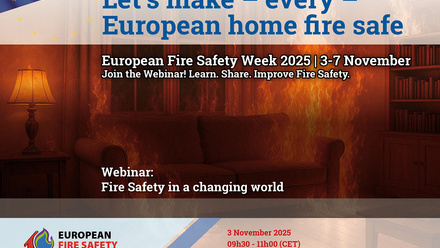A changing landscape of risk, responsibility, and resilience
Europe’s transition toward a decarbonised, electrified future is one of the most significant societal shifts of our time. This transformation—driven by the rapid deployment of renewable energy, electrification of transport, and the digitalisation of infrastructure—is changing not only how we power our economies but also how we live, move, and build. Technologies like electric vehicles (EVs), battery energy storage systems (BESS), photovoltaic solar panels, wind turbines, hydrogen facilities, and smart infrastructure have moved from the periphery into the mainstream. They are now embedded in our homes, cities, and critical infrastructure.
Parallel shift
Yet with this transformation comes a parallel shift in how we must think about fire safety and security. While the technologies driving the energy transition are essential for addressing climate change, they also bring unfamiliar risks that challenge traditional safety frameworks.
The fire hazards associated with lithium-ion batteries, for example, are well known within the industry. Thermal runaway in EVs and battery storage systems can result in fires that are difficult to suppress and predict. At the same time, battery-operated devices in consumer and commercial settings are becoming ubiquitous, expanding potential ignition sources in environments not originally designed for them.
Photovoltaic systems, often installed on rooftops or integrated into building façades, introduce new complexities in firefighting operations. These systems remain electrically active even when disconnected from the grid, posing electrocution hazards and altering fire dynamics within buildings. Wind turbines, particularly those installed offshore, present unique challenges related to fire suppression, access, and evacuation—especially when emergency response capabilities are limited by location and weather conditions.
Hydrogen technologies, which are poised to play a major role in energy storage and mobility, demand a new approach to fire safety due to the fuel’s high volatility and storage under high pressure. Battery recycling and warehousing facilities are multiplying as demand for rare materials grows, yet the safety protocols governing these environments are still catching up. And as the grid itself becomes smarter and more distributed, ensuring the safety and security of critical infrastructure is no longer just about physical protection—it now includes resilience against cyber threats and system failures.
Regulatory grey area
Many of these new risks fall into a regulatory grey area. Existing building codes, fire protection standards, and emergency response procedures were not developed with today’s technologies in mind. This has created a risk gap, where the pace of technological adoption has outstripped the evolution of safety frameworks, training, and enforcement mechanisms. Too often, fire and security considerations are addressed late in the process, or worse, overlooked entirely when new technologies are introduced.
Bridging the gap
Bridging this gap requires a collaborative, cross-sectoral approach. Fire safety professionals, emergency responders, system designers, regulators, policymakers, and manufacturers must work more closely than ever to anticipate risks, share knowledge, and adapt solutions. This means revisiting and updating standards and codes to reflect current realities, investing in innovation for detection and suppression technologies, and ensuring that lessons from real-world incidents are shared openly to inform better practices.
Training also plays a crucial role. Safety professionals and technicians must be equipped to operate in these new environments—whether that means understanding the behaviour of batteries in enclosed spaces, navigating PV-equipped rooftops during a fire, or managing the risks associated with hydrogen storage and transport. Resilience of critical infrastructure must be ensured not only through robust physical design but through secure, interoperable systems that can respond to disruption—whether natural, accidental, or malicious.
Integral part of energy transition
Euralarm, as the European voice of the fire safety and security industry, is committed to supporting this evolution. Our work with stakeholders across Europe reflects a shared understanding that safety and security must be integral to the energy transition, not an afterthought. We advocate for consistent regulation across Europe, recognising that fragmented standards hinder both innovation and safety. We also help foster partnerships between industry, authorities, and knowledge institutions to ensure emerging technologies are matched with appropriate safety solutions.
Euralarm plays an active role in aligning industry efforts, promoting best practices, and raising awareness of the changing risk landscape. We also support professional training, standard development, and research initiatives that aim to keep pace with technological change. Most importantly, we encourage proactive engagement—anticipating the safety challenges of tomorrow rather than reacting to the failures of today.
Series of articles
This article marks the beginning of a series exploring how fire safety and security intersect with Europe’s energy transition. In the coming months, we will delve into specific technologies and sectors—from EVs and solar panels to hydrogen and smart buildings—examining how the risk landscape is shifting, what solutions are being developed, and where critical gaps remain.
Our goal is to stimulate dialogue, share insights, and encourage action. We invite professionals across disciplines—engineers, firefighters, facility managers, planners, regulators, and business leaders—to engage in this conversation. The path to a decarbonised future must be not only innovative and sustainable, but also safe and secure.




